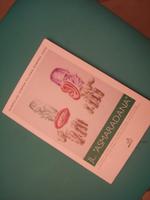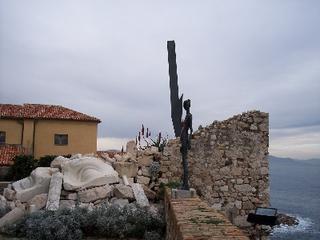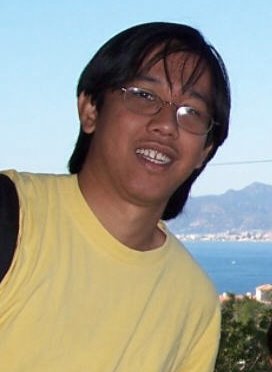 This message is about a book I have just finished. The book title is
This message is about a book I have just finished. The book title is Jl. Asmarandana. Kumpulan Cerpen Pilihan Kompas 2005
. It is a collection of selected short stories appeared in Sunday edition of Kompas newspaper. Ten short stories are selected from 50 published in the newspaper in 2004.
Sewaktu ke Indonesia bulan Agustus yang lalu, saya sempatkan untuk beli buku sastra terbaru. Banyak buku yang menarik, tapi akhirnya saya hanya beli dua buku,
Pintunya Fira Basuki, dan
Jl. Asmarandana. Kumpulan Cerpen Pilihan Kompas 2005. Buku yang pertama harus saya bilang tidak terlalu menarik dan terlalu banyak bermain simbol-simbol yang repetitif. Tapi, tentu saja saya bakal menulis sedikit tentang itu di blog ini. Buku kedua, sebaliknya. Saya menyukai buku itu, karena bukunya digarap baik, cerpen-cerpennya menarik, bahkan ilustrasinya pun mengesankan.
Buku
Jl. Asmarandana. Kumpulan Cerpen Pilihan Kompas 2005 memuat pilihan cerpen-cerpen yang pernah dimuat di surat kabar Kompas Minggu tahun 2004. Kumpulan cerpen Kompas ini bukanlah yang pertama, dan sewaktu saya menelusuri buku-buku di Gramedia, saya paling tidak menyadari keberadaan kumpulan cerpen Kompas tahun yang lain. Hanya saja, sesuai niatan awal, saya hanya ingin membaca yang terbaru.
Jl. Asmarandana, namun demikian adalah Kumpulan cerpen Kompas pertama buat saya.
Cerpen yang dimuat dalam buku ini berjumlah sepuluh. Sepuluh saja dari lima puluh cerpen -- sekitar 15 atau 17 biasanya -- menurut Kenedi Nurhan, salah seorang dewan juri, karena mereka hendak teguh pada kriteria yang mereka terapkan di awal pemilihan. Kriteria itu adalah cerpen-cerpen yang dimuat dalam buku ini harus dipilih oleh separuh dewan juri dalam sekali pemilihan. Dewan juri sendiri mengakui bahwa kualitas cerpen-cerpen yang dimuat tahun 2004 mengalami penurunan kualitas.
Kesepuluh cerpen itu adalah
Rt03 Rw22: Jalan Belimbing atau Jalan Asmarandana (Kuntowijoyo),
Kupu-kupu Seribu Peluru (Agus Noor),
Senja Buram, Daging di Mulutnya (Radhar Panca Dahana),
Belatung (Gus Tf Sakai),
Dari Mana Datangnya Mata (Veven Sp Wardhana),
Sepasang Kera yang Berjalan dari Pura ke Pura (Sunaryono Basuki Ks),
Bulan Terbingkai Jendela (Indra Tranggono),
Baju (Ratna Indaswari Ibrahim),
Daun-daun Waru di Samirono (Nh Dini), dan
Roti Tawar (Kurnia Effendi).
Bila saya harus memilih tiga dari sepuluh cerpen itu, maka saya akan memilih berturutan
Rt03 Rw22: Jalan Belimbing atau Jalan Asmarandana, Daun-daun Waru di Samirono, dan
Dari Mana Datangnya Mata.
Kuntowijoyo dalam
Jalan Asmarandana, yang dinobatkan sebagai cerpen terbaik dalam buku ini mengangkat tema sederhana. Seorang ketua RT lulusan S3 ilmu politik dari Amerika mengalami kesulitan mengatasi konflik antar warganya, antara pasangan Said dan istrinya yang baru saja menikah dengan Pak Dwiyatmo yang baru saja kehilangan istrinya. Dengan cara bertutur yang sederhana, pernciptaan karakter yang kuat, dan humor yang menyegarkan dalam cerpennya ini, Kuntowijoyo almarhum memang layak untuk mendapat penghargaan cerpen terbaik. Saya setuju dengan dewan juri.
Daun-daun Waru di Samirono karya Nh. Dini juga menceritakan sesuatu yang sederhana dan kuat. Cerpen ini bercerita tentang seorang nenek bernama Mbah (atau Lik atau Mak tergantung pemanggilnya) Jum yang berprofesi tetap sebagai pengumpul daun waru untuk dijual kepada para penjual tempe. Mbah Jum, seorang wong cilik yang bagi banyak orang mungkin dianggap sebagai korban ditampilkan sebagai seorang yang justru berkarakter kuat. Dibingkai dengan setting budaya Jawa, membuat cerpen ini indah dan mengesankan.
Pola lantunan yang digunakan Veven Sp Wardhana adalah salah satu yang membuat
Dari Mana Datangnya Mata meninggalkan kesan buat saya.
Ada yang menyelipkan belati di balik kutang.Ada yang melilitkan pedang di balik setagen di pinggang.
Atau
Aku suka berendam hingga terbenam tanpa aku sadari aku tenggelam berpadu dengan penggunaan simbol-simbol untuk menutupi cerita seksualitas membuat cerpen ini menyenangkan untuk dibaca.
Cerpen-cerpen lain tak kalah menariknya.
Belatung, gabungan dari metaforis dan realis adalah cerpen yang sangat baik.
Kupu-kupu Seribu Peluru sangat menjanjikan, menyajikan cerita dengan penuh pesona.
Senja Buram, Daging di Mulutnya , cerpen berkecendrungan surealis menarik untuk dibaca walaupun mungkin terlalu rumit.
Roti Tawar, cerpen sederhana dengan tema yang mungkin tak sesederhana penampilannya, menyembunyikan banyak kemungkinan.
Baju dan
Berjalan dari Pura ke Pura tak terlalu mengesankan meski mungkin tema yang digarap menarik. Sedangkan bagi saya
Bulan Terbingkai Jendela tidaklah terlalu menarik, agak mengejutkan bahwa cerpen ini menjadi salah satu dari tiga cerpen terbaik bagi dewan juri.
Selain cerpen-cerpen di atas, buku ini juga dihiasi oleh kritik Jean Couteau di awal buku, dan Budi Darma di akhir. Keduanya tidak terlalu istimewa. Mungkin karena waktu yang mereka habiskan tak sama dengan waktu yang dihabiskan penulis-penulis cerpen.
Tak lupa, sebelum menutup message ini, ilustrasi di setiap awal cerpen menunjukkan bagaimana seriusnya buku ini digarap.
Read more/ Suite /
Selengkapnya!

 The museum itself is awesome, it is a three levels medieval castel called Grimaldi Castel. Picasso lived and worked there in 1946 accompanied by his spouse François Gilot. The most important work fulfilled in the period is the Joie de Vivre, a picture that is representative to his mood at the time: the joy of life.
The museum itself is awesome, it is a three levels medieval castel called Grimaldi Castel. Picasso lived and worked there in 1946 accompanied by his spouse François Gilot. The most important work fulfilled in the period is the Joie de Vivre, a picture that is representative to his mood at the time: the joy of life.


